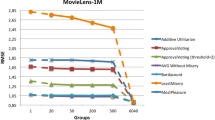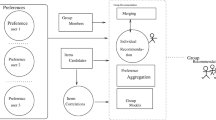Abstract
In the study of collaborative filtering, scholars and professionals alike have given much attention to user responses of the “one-class” type, feedback like online transactions or “likes”. Such behavior gauges have been integral to many ambient intelligent and context-aware recommendation systems, in which users are furnished with personalized lists of items according to their exhibited tastes. These one-class data, earlier studies have shown, are readily grasped by Bayesian personalized ranking, a pairwise preference assumption. Nevertheless, these works fail to make sufficient use of item similarity models using group preference. To improve performance, we argue in this paper, it is necessary to develop a model that yokes a User preference model to the Group Preference-based Similarity models (called UGPS). UCPG will produce a greater depth of interactions, we argue, because it takes on an entire set of items as opposed to the solitary item used previously. Moreover, a number of clustering methods have been put to work in group preference-based recommendation systems, but there is no consensus as to which offers superior accuracy. To gain clarity, we first built up a pair of versions of UGPS in order to assess the recommendation performances of different approaches to group generation: UGPS-1, which employed K-means, and UGPS-2, using K-NN—according to how efficiently they group their output. This comparison revealed that UGPS-1 tended to improve its recommendation performance as the number of groups and representative item sets grew. In contrast, UGPS-2 exhibited the opposite effect: recommendation performance declined as the number of groups and representative item sets expanded. Lastly, we consider how our UGPS system works with various sophisticated approaches on four real datasets, and demonstrate that UGPS produces more accurate recommendations.




Similar content being viewed by others
References
Amer-Yahia S, Roy SB, Chawlat A, Das G, Yu C (2009) Group recommendation: semantics and efficiency. Proc VLDB Endow 2:754–765
Davidson J, Liebald B, Liu J, Nandy P, Van Vleet T, Gargi U, Sampath D (2010) The YouTube video recommendation system. In: Proceedings of the fourth ACM conference on recommender systems, pp 293–296
Durao F, Dolog P (2014) Improving tag-based recommendation with the collaborative value of wiki pages for knowledge sharing. J Ambient Intell Humaniz Comput 5:21–38
González G, de la Rosa JL, Dugdale J, Pavard B, El Jed M, Pallamin N, Klann M (2006) Towards ambient recommender systems: results of new cross-disciplinary trends. In: Proceedings of ECAI workshop on recommender systems
He R, McAuley J (2016) Fusing similarity models with markov chains for sparse sequential recommendation. In: Data mining (ICDM), 2016 IEEE 16th international conference on, pp 191–200
Hooshyar D, Yousefi M, Lim H (2017) A systematic review of data-driven approaches in player modeling of educational games. Artif Intell Rev. https://doi.org/10.1007/s10462-017-9609-8
Hooshyar D, Yousefi M, Lim H (2018a) Data-driven approaches to game player modeling: a systematic literature review. ACM Comput Surv 50(6):90
Hooshyar D, Yousefi M, Wang M, Lim H (2018b) A data-driven procedural-content-generation approach for educational games. J Comput Assisted Learn. https://doi.org/10.1111/jcal.12280
Kabbur S, Ning X, Karypis G (2013) Fism: factored item similarity models for top-n recommender systems. In: Proceedings of the 19th ACM SIGKDD international conference on knowledge discovery and data mining, pp 659–667
Kanagal B, Ahmed A, Pandey S, Josifovski V, Yuan J, Garcia-Pueyo L (2012) Supercharging recommender systems using taxonomies for learning user purchase behavior. Proc VLDB Endow 5:956–967
Karidi DP, Stavrakas Y, Vassiliou Y (2017) Tweet and followee personalized recommendations based on knowledge graphs. J Ambient Intell Humaniz Comput. https://doi.org/10.1007/s12652-017-0491-7
Krohn-Grimberghe A, Drumond L, Freudenthaler C, Schmidt-Thieme L (2012) Multi-relational matrix factorization using Bayesian personalized ranking for social network data. In: Proceedings of the fifth ACM international conference on web search and data mining, pp 173–182
Mashal I, Alsaryrah O, Chung TY (2016) Testing and evaluating recommendation algorithms in internet of things. J Ambient Intell Humaniz Comput 7:889–900
Ning X, Karypis G (2011) Slim: sparse linear methods for top-n recommender systems. In: Data mining (ICDM), 2011 IEEE 11th international conference on, pp 497–506
Otebolaku AM, Andrade MT (2015) Context-aware media recommendations for smart devices. J Ambient Intell Humaniz Comput 6:13–36
Pan W, Chen L (2013) Cofiset: collaborative filtering via learning pairwise preferences over item-sets. In: Proceedings of the 2013 SIAM international conference on data mining, pp 180–188
Rendle S, Freudenthaler C (2014) Improving pairwise learning for item recommendation from implicit feedback. In: Proceedings of the 7th ACM international conference on web search and data mining, pp 273–282
Rendle S, Freudenthaler C, Gantner Z, Schmidt-Thieme L (2009) BPR: Bayesian personalized ranking from implicit feedback. In: Proceedings of the twenty-fifth conference on uncertainty in artificial intelligence, pp 452–461
Rendle S, Freudenthaler C, Schmidt-Thieme L (2010) Factorizing personalized markov chains for next-basket recommendation. In: Proceedings of the 19th international conference on world wide web, pp 811–820
Francesco R, Lior R, Bracha S (2011) Introduction to recommender systems handbook. In: Francesco R, Lior R, Bracha S, Paul BK (eds) Recommender systems handbook. Springer, New York, pp 1–35
Shi Y, Karatzoglou A, Baltrunas L, Larson M, Hanjalic A, Oliver N (2012) TFMAP: optimizing MAP for top-n context-aware recommendation. In: Proceedings of the 35th international ACM SIGIR conference on research and development in information retrieval, pp 155–164
Yun Y, Hooshyar D, Jo J, Lim H (2018) Developing a hybrid collaborative filtering recommendation system with opinion mining on purchase review. J Inf Sci 44:331–344
Zhao T, McAuley J, King I (2014) Leveraging social connections to improve personalized ranking for collaborative filtering. In: Proceedings of the 23rd ACM international conference on conference on information and knowledge management, pp 261–270
Acknowledgements
This work was supported by the National Research Foundation of Korea (NRF) Grant funded by the Korea government (MSIT) (nos. NRF-2016R1A2B2015912 and NRF-2017M3C4A7068189).
Author information
Authors and Affiliations
Corresponding author
Additional information
Publisher’s Note
Springer Nature remains neutral with regard to jurisdictional claims in published maps and institutional affiliations.
Rights and permissions
About this article
Cite this article
Yang, Y., Hooshyar, D., Jo, J. et al. A group preference-based item similarity model: comparison of clustering techniques in ambient and context-aware recommender systems. J Ambient Intell Human Comput 11, 1441–1449 (2020). https://doi.org/10.1007/s12652-018-1039-1
Received:
Accepted:
Published:
Issue Date:
DOI: https://doi.org/10.1007/s12652-018-1039-1




